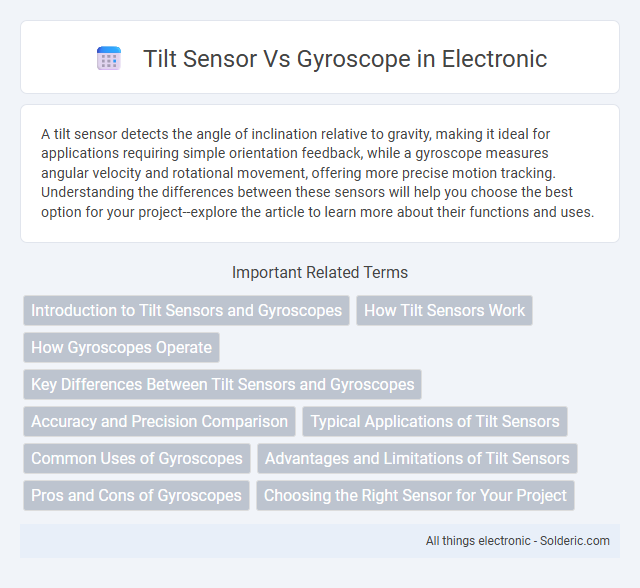A tilt sensor detects the angle of inclination relative to gravity, making it ideal for applications requiring simple orientation feedback, while a gyroscope measures angular velocity and rotational movement, offering more precise motion tracking. Understanding the differences between these sensors will help you choose the best option for your project--explore the article to learn more about their functions and uses.
Comparison Table
| Feature | Tilt Sensor | Gyroscope |
|---|---|---|
| Function | Measures tilt angle relative to gravity | Measures angular velocity and rotational rate |
| Output | Angle or tilt position | Angular velocity (degrees/sec or radians/sec) |
| Use Case | Orientation detection, level measurement | Rotation tracking, motion sensing |
| Technology | Accelerometer or MEMS-based | MEMS or mechanical gyroscopes |
| Accuracy | Good for static angle measurement | High accuracy for dynamic rotational movement |
| Sensitivity | Detects tilt changes, less sensitive to fast motion | Detects rapid angular velocity changes |
| Power Consumption | Generally lower | Higher compared to tilt sensors |
| Applications | Smartphones, gaming controllers, robotics | Drones, VR systems, inertial navigation |
| Cost | Lower cost | Higher cost |
Introduction to Tilt Sensors and Gyroscopes
Tilt sensors detect angular displacement relative to gravity, providing precise information about device orientation in a single axis. Gyroscopes measure angular velocity across multiple axes, enabling detection of rotational motion and maintaining orientation stability. Your choice depends on whether simple tilt detection or comprehensive rotational tracking is required for your application.
How Tilt Sensors Work
Tilt sensors detect the angle of inclination by measuring changes in position relative to the force of gravity, often using a fluid-filled chamber or a pendulum that shifts when tilted. Gyroscopes, on the other hand, use the principles of angular momentum to measure rotational movement rather than static tilt. Understanding how tilt sensors work can help you choose the right device for applications requiring accurate angle detection without the complexity of rotational dynamics.
How Gyroscopes Operate
Gyroscopes operate by measuring angular velocity using the principles of angular momentum, typically through a spinning rotor or vibrating structure that maintains its orientation regardless of device movement. This allows them to detect rotational motion and provide precise information about an object's orientation and angular velocity in three-dimensional space. Unlike tilt sensors, which only measure inclination relative to gravity, gyroscopes deliver dynamic rotational data essential for navigation, stabilization, and motion sensing applications.
Key Differences Between Tilt Sensors and Gyroscopes
Tilt sensors measure the angular position relative to gravity, providing direct information about the object's orientation along one or two axes, while gyroscopes measure angular velocity, detecting rotational movement in three dimensions. Tilt sensors are typically simpler, more cost-effective, and consume less power, making them ideal for basic applications such as device leveling and orientation detection. Gyroscopes offer higher precision and dynamic response suited for complex motion tracking, navigation systems, and stabilization in drones, robotics, and smartphones.
Accuracy and Precision Comparison
Tilt sensors provide accurate measurements for static angles but lack precision during dynamic motion due to sensitivity to vibrations. Gyroscopes deliver high precision and reliable angular velocity data, making them superior for tracking rapid orientation changes. Your choice depends on whether you prioritize accurate static angle detection or precise dynamic motion tracking.
Typical Applications of Tilt Sensors
Tilt sensors are commonly used in applications such as automotive safety systems for detecting vehicle rollover, industrial machinery for monitoring equipment position, and consumer electronics for screen orientation control. These sensors are integral to construction equipment to ensure correct leveling and in robotics for balance and navigation. Their simplicity and reliability make them ideal for static or slow-moving object tilt measurement.
Common Uses of Gyroscopes
Gyroscopes are commonly used in navigation systems, such as aircraft, ships, and smartphones, to measure orientation and angular velocity accurately. They provide critical data for stabilizing drones and other autonomous vehicles, ensuring precise control and balance. In consumer electronics, gyroscopes enable features like motion sensing for gaming and augmented reality applications.
Advantages and Limitations of Tilt Sensors
Tilt sensors offer simple and cost-effective solutions for measuring angular displacement relative to gravity, making them ideal for applications like leveling and orientation detection. Their advantages include low power consumption, compact size, and high reliability in static or slow-moving environments. Limitations arise from reduced accuracy during dynamic motion, sensitivity to external vibrations, and inability to measure rotational velocity compared to gyroscopes.
Pros and Cons of Gyroscopes
Gyroscopes offer precise angular velocity measurements crucial for navigation, gaming, and robotics, providing excellent sensitivity and stability over time. Their drawbacks include higher cost, increased complexity, and susceptibility to drift without calibration, impacting long-term accuracy. Compared to tilt sensors, gyroscopes excel in detecting rotational motion but require more power and sophisticated signal processing.
Choosing the Right Sensor for Your Project
Selecting the right sensor depends on the specific requirements of your project, where a tilt sensor measures static orientation relative to gravity, ideal for detecting simple angles or inclines. A gyroscope provides precise measurements of angular velocity and rotation, making it suitable for applications requiring dynamic motion tracking or stabilization, such as drones and mobile devices. Understanding whether you need accurate rotational data or basic tilt detection will guide you toward the best sensor for your project's performance needs.
tilt sensor vs gyroscope Infographic

 solderic.com
solderic.com